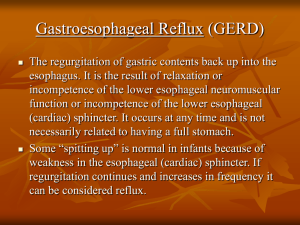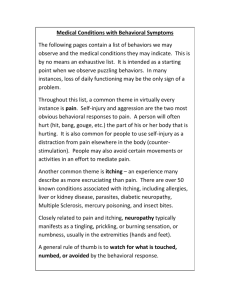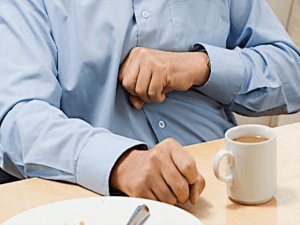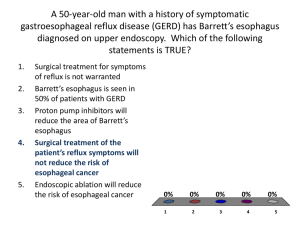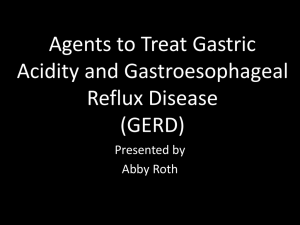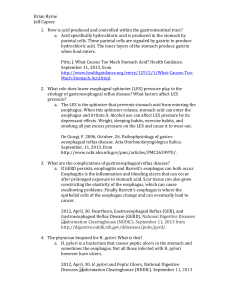The GI Blues: Heartburn, Acid Reflux and Indigestion Byron Cryer, M.D.
advertisement
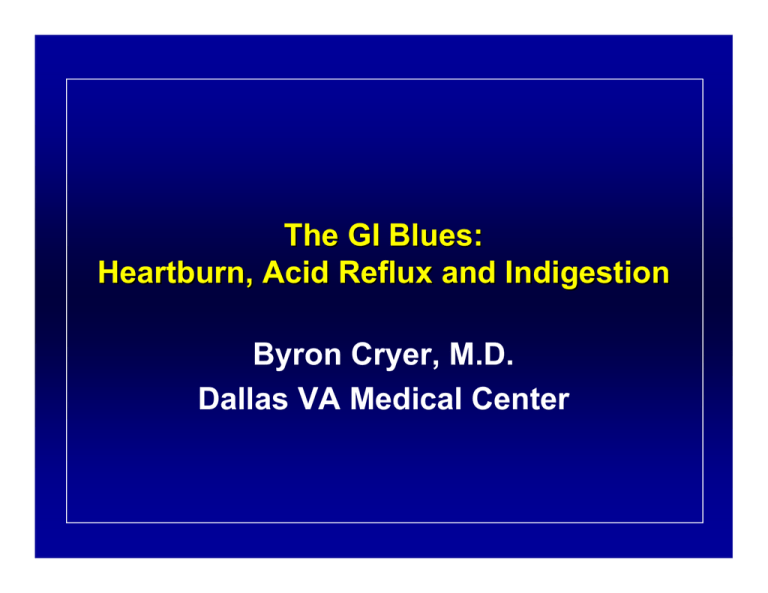
The GI Blues: Heartburn, Acid Reflux and Indigestion Byron Cryer, M.D. Dallas VA Medical Center Upper GI Symptoms are Common Caucasian Female Population (45-75 years of age) 60% % Prevalence 50% 46% 39% 40% 30% 20% 19% 10% 0% Dyspepsia Heartburn Locke HR et al. Gastroenterology. 1997;112(5):1448-1456 Acid Regurgitation Gastroesophageal Reflux GERD Defined Acid reflux (gastroesophageal reflux) is a back-flow of stomach contents upward into the esophagus. Acid refluxes when the lower esophageal sphincter is not functioning properly. The patient with GERD Gastroesophageal Reflux Signs, Symptoms & Complications Symptom: Heartburn Sign: Esophagitis. Complications: Esophageal ulcer Bleeding Barrett’s esophagus (replacement of squamous with columnar epithelium Adenocarcimoma. Harrison’s Principles of Internal Medicine. Thirteenth Ed. 1998. Heartburn The Cardinal Symptom of GERD • An uncomfortable, burning sensation located beneath the sternum • Radiates up the chest • Described with wave of open hand • Often associated with regurgitation • Relieved by antacids and antisecretory medications Heartburn The Cardinal Symptom of GERD • An uncomfortable, burning sensation located beneath the sternum • Radiates up the chest • Described with wave of open hand • Often associated with regurgitation • Relieved by antacids and antisecretory medications The patient with GERD Heartburn The Cardinal Symptom of GERD • An uncomfortable, burning sensation located beneath the sternum • Radiates up the chest • Described with wave of open hand • Often associated with regurgitation • Relieved by antacids and antisecretory medications Factors that Promote Gastroesophageal Reflux 1. Increased gastric volume (after meal, gastric stasis, acid hypersecretion). 2. Contents near esophageal junction (bending, recumbency). 3. Increased gastric pressure (obesity, tight clothes, pregnancy, ascites). 4. Loss of LES-gastric pressure gradient: LES pressure decrease by smoking, anticholinergics, Ca antagonists, pregnancy, scleroderma. Harrison’s Principles of Internal Medicine. Thirteenth Ed. 1998. Factors that Promote Gastroesophageal Reflux 1. Increased gastric volume (after meal, gastric stasis, acid hypersecretion). 2. Contents near esophageal junction (bending, recumbency). 3. Increased gastric pressure (obesity, tight clothes, pregnancy, ascites). 4. Loss of LES-gastric pressure gradient: LES pressure decrease by smoking, anticholinergics, Ca antagonists, pregnancy, scleroderma. Harrison’s Principles of Internal Medicine. Thirteenth Ed. 1998. Antireflux Function of Crural Diaphragm “Atypical” Manifestations of GERD Manifestation Due to reflux into Chest pain Esophagus Globus Sore throat Burning tongue Dental erosions Sinusitis Oropharynx Laryngitis Chronic cough Asthma Airway Gastroesophageal Reflux Signs, Symptoms & Complications Symptom: Heartburn Sign: Esophagitis. Complications: Esophageal ulcer Bleeding Barrett’s esophagus (replacement of squamous with columnar epithelium Adenocarcimoma. Harrison’s Principles of Internal Medicine. Thirteenth Ed. 1998. Gastroesophageal Reflux Disease (GERD) The condition in which gastric juice that refluxes into the esophagus and oropharynx causes symptoms, tissue injury, or both. Peptic Esophageal Stricture Gastroesophageal Reflux Treatment Lifestyle modifications: Weight reduction, sleeping with head elevated or on wedge. Avoidance of smoking, large meals, caffeine, alcohol, chocolate, fatty foods, citrus juices, NSAIDs. Medical Therapy: • Antacids: mostly used prn • H2-blockers : (cimetidine, ranitidine, famotidine, nizatidine) all BID • Proton Pump Inhibitors: Esomeprazole, Lansoprazole,Omeprazole Pantoprazole, Rabeprazole • Agents that increase LES pressure: Cisapride 10-20 mg PO QID Metoclopramide 10 mg PO QID Surgical Therapy: In severe and refractory cases: Nissen fundoplication Fennerty, M.B. “Medical treatment of gastroesophageal reflux disease in the managed care environment” Seminars in Gastrointestinal Disease 1997;8 (2):90-99. Antireflux Life-Style Modifications • Elevate head of bed • Weight loss for overweight patients • Avoid: – Recumbency after meals – Bedtime snacks – Cigarette smoking – Alcohol – Foods that promote reflux – Medications that promote reflux Lifestyle modifications for GERD: Often Illogical! Gastroesophageal Reflux Treatment Lifestyle Modifications: Weight reduction, sleeping with head elevated or on wedge. Avoidance of smoking, large meals, caffeine, alcohol, chocolate, fatty foods, citrus juices, NSAIDs. Medical Therapy: • Antacids: mostly used prn • H2-blockers : (cimetidine, ranitidine, famotidine, nizatidine) all BID • Proton Pump Inhibitors: Esomeprazole, Lansoprazole,Omeprazole Pantoprazole, Rabeprazole • Agents that increase LES pressure: Cisapride 10-20 mg PO QID Metoclopramide 10 mg PO QID Surgical Therapy: In severe and refractory cases: Nissen fundoplication Endoscopic anti-reflux procedures: Fennerty, M.B. “Medical treatment of gastroesophageal reflux disease in the managed care environment” Seminars in Gastrointestinal Disease 1997;8 (2):90-99. Gastroesophageal Reflux Treatment Lifestyle Modifications: Weight reduction, sleeping with head elevated or on wedge. Avoidance of smoking, large meals, caffeine, alcohol, chocolate, fatty foods, citrus juices, NSAIDs. Medical Therapy: • Antacids: mostly used prn • H2-blockers : (cimetidine, ranitidine, famotidine, nizatidine) all BID • Proton Pump Inhibitors: Esomeprazole, Lansoprazole,Omeprazole Pantoprazole, Rabeprazole • Agents that increase LES pressure: Cisapride 10-20 mg PO QID Metoclopramide 10 mg PO QID Surgical Therapy: In severe and refractory cases: Nissen fundoplication Endoscopic anti-reflux procedures: Fennerty, M.B. “Medical treatment of gastroesophageal reflux disease in the managed care environment” Seminars in Gastrointestinal Disease 1997;8 (2):90-99. H2 – Receptor Antagonists Histamine H2-Receptor Blockers • Cimetidine (Tagamet), ranitidine (Zantac), famotidine (Pepcid), nizatidine (Axid) • Heal GERD symptoms and signs in 50% to 65% • Few side effects • Most useful for mild GERD • Tolerance develops frequently Medical Therapy of GERD • The modern medical therapy of GERD is directed primarily at decreasing gastric acid secretion. • “Step-up” vs. “step-down” approach Gastroesophageal Reflux Treatment Lifestyle Modifications: Weight reduction, sleeping with head elevated or on wedge. Avoidance of smoking, large meals, caffeine, alcohol, chocolate, fatty foods, citrus juices, NSAIDs. Medical Therapy: • Antacids: mostly used prn • H2-blockers : (cimetidine, ranitidine, famotidine, nizatidine) all BID • Proton Pump Inhibitors: Esomeprazole, Lansoprazole,Omeprazole Pantoprazole, Rabeprazole • Agents that increase LES pressure: Cisapride 10-20 mg PO QID Metoclopramide 10 mg PO QID Surgical Therapy: In severe and refractory cases: Nissen fundoplication Endoscopic anti-reflux procedures: Fennerty, M.B. “Medical treatment of gastroesophageal reflux disease in the managed care environment” Seminars in Gastrointestinal Disease 1997;8 (2):90-99. Proton Pump Inhibitors Proton Pump Inhibitors (PPIs) • Omeprazole (Prilosec), lansoprazole (Prevacid), rabeprazole (Aciphex), pantoprazole (Protonix), esomeprazole (Nexium) • Heal GERD symptoms and signs in 80% to 100% • Few side effects • Tolerance not documented • First-line therapy for severe GERD Maintenance of GERD Remission Patients in Remission 100% 90% 80% 70% 60% 50% 40% 30% 20% 10% 0% PPI Daily PPI Weekend H2-Blocker Daily 0 2 4 6 8 10 Months of Maintenance Therapy 12 Dent. Gut 1994;35:590. Therapeutic Options in the Treatment of GERD • Lifestyle modifications • Pharmacological Agents Prokinetic Agents Anti-secretory Agents H2-receptor antagonists Proton pump inhibitors • Anti-reflux surgery • Endoscopic anti-reflux procedures Therapeutic Options in the Treatment of GERD • Lifestyle modifications • Pharmacological Agents Prokinetic Agents Anti-secretory Agents H2-receptor antagonists Proton pump inhibitors • Anti-reflux surgery • Endoscopic anti-reflux procedures Bard® Endoscopic Suturing System The EndoCinch Procedure The EndoCinch Procedure Failed EndoCinch Procedure StrettaTM Radiofrequency Energy System Electrodes The Stretta Procedure Four antegrade rings Two gastric cardia rings • 8 lesions at each of 4 esophageal levels • 12 lesions at each of 2 cardia levels = 56 lesions The Stretta Procedure Endoscopic Plication System pledgets retractor gastroscope Endoscopic Full-Thickness Plication 1 Plicator and gastroscope retroflexed to GEJ in anterior position. 4 2 Arms opened, tissue retractor advanced to serosa. Single, pre-tied implant is deployed, securing serosato-serosa plication. 5 3 Gastric wall retracted, arms closed. Full-thickness plication restructures normal antireflux barrier. Endoscopic Full-Thickness Plication Technique 1. Wall retractor advanced to serosa; device arms opened 2. Gastric wall retracted 3. Device arms close deploying pre-tied implant 4. Full-thickness plication This device has not been approved by the Food & Drug Administration. Enteryx™ injection into the region of the LES Enteryx™ GERD: The role of surgery

